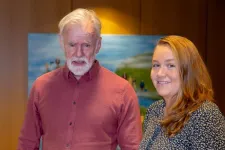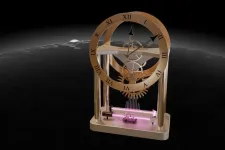(Press-News.org) It’s 7 billion years ago, and the universe’s heyday of star formation is beginning to slow. What might our Milky Way galaxy have looked like at that time? Astronomers using NASA’s James Webb Space Telescope have found clues in the form of a cosmic question mark, the result of a rare alignment across light-years of space.
“We know of only three or four occurrences of similar gravitational lens configurations in the observable universe, which makes this find exciting, as it demonstrates the power of Webb and suggests maybe now we will find more of these,” said astronomer Guillaume Desprez of Saint Mary’s University in Halifax, Nova Scotia, a member of the team presenting the Webb results.
While this region has been observed previously with NASA’s Hubble Space Telescope, the dusty red galaxy that forms the intriguing question-mark shape only came into view with Webb. This is a result of the wavelengths of light that Hubble detects getting trapped in cosmic dust, while longer wavelengths of infrared light are able to pass through and be detected by Webb’s instruments.
Astronomers used both telescopes to observe the galaxy cluster MACS-J0417.5-1154, which acts like a magnifying glass because the cluster is so massive it warps the fabric of space-time. This allows astronomers to see enhanced detail in much more distant galaxies behind the cluster. However, the same gravitational effects that magnify the galaxies also cause distortion, resulting in galaxies that appear smeared across the sky in arcs and even appear multiple times. These optical illusions in space are called gravitational lensing.
The red galaxy revealed by Webb, along with a spiral galaxy it is interacting with that was previously detected by Hubble, are being magnified and distorted in an unusual way, which requires a particular, rare alignment between the distant galaxies, the lens, and the observer — something astronomers call a hyperbolic umbilic gravitational lens. This accounts for the five images of the galaxy pair seen in Webb’s image, four of which trace the top of the question mark. The dot of the question mark is an unrelated galaxy that happens to be in the right place and space-time, from our perspective.
In addition to producing a case study of the Webb NIRISS (Near-Infrared Imager and Slitless Spectrograph) instrument’s ability to detect star formation locations within a galaxy billions of light-years away, the research team also couldn’t resist highlighting the question mark shape. “This is just cool looking. Amazing images like this are why I got into astronomy when I was young,” said astronomer Marcin Sawicki of Saint Mary’s University, one of the lead researchers on the team.
“Knowing when, where, and how star formation occurs within galaxies is crucial to understanding how galaxies have evolved over the history of the universe,” said astronomer Vicente Estrada-Carpenter of Saint Mary’s University, who used both Hubble’s ultraviolet and Webb’s infrared data to show where new stars are forming in the galaxies. The results show that star formation is widespread in both. The spectral data also confirmed that the newfound dusty galaxy is located at the same distance as the face-on spiral galaxy, and they are likely beginning to interact.
“Both galaxies in the Question Mark Pair show active star formation in several compact regions, likely a result of gas from the two galaxies colliding,” said Estrada-Carpenter. “However, neither galaxy’s shape appears too disrupted, so we are probably seeing the beginning of their interaction with each other.”
“These galaxies, seen billions of years ago when star formation was at its peak, are similar to the mass that the Milky Way galaxy would have been at that time. Webb is allowing us to study what the teenage years of our own galaxy would have been like,” said Sawicki.
The Webb images and spectra in this research came from the Canadian NIRISS Unbiased Cluster Survey (CANUCS). The research paper is published in the Monthly Notices of the Royal Astronomical Society.
The James Webb Space Telescope is the world’s premier space science observatory. Webb is solving mysteries in our solar system, looking beyond to distant worlds around other stars, and probing the mysterious structures and origins of our universe and our place in it. Webb is an international program led by NASA with its partners, ESA (European Space Agency) and CSA (Canadian Space Agency).
END
NASA’s Webb reveals distorted galaxy forming cosmic question mark
2024-09-04
ELSE PRESS RELEASES FROM THIS DATE:
Three common variants increase the risk of Wolff-Parkinson-White syndrome
2024-09-04
Three common variants increase the risk of Wolff-Parkinson-White syndrome
Study by scientists at deCODE genetics/Amgen and collaborators in Denmark and the USA, on the genetics of accessory conduction pathways in the heart (Wolff-Parkinson-White syndrome), reveals that accessory pathways can cause rhythm disturbances, characterized by an overly fast heartbeat, which can be life-threatening.
Accessory pathways are found among around 0.3% of individuals, but their prevalence is likely higher as a majority of them do not cause symptoms that lead to diagnosis. It is believed that other individual factors can influence the likelihood of developing rhythm ...
AERA selects Elise Boddie to deliver 2024 Brown Lecture in Education Research
2024-09-04
Washington, D.C., September 4, 2024—Elise Boddie, James V. Campbell Professor of Law at the University of Michigan Law School, has been selected by AERA to present the 2024 Brown Lecture in Education Research. Her lecture, titled “Brown v. Board of Education and the Democratic Ideals,” will take place on Thursday, October 24, 6:30 p.m. ET, at Howard University in Washington, D.C., and will be livestreamed. Registration for in-person attendance and for the livestream will open in early September. The event is free and ...
Brown to lead $2.8 million NSF grant to create an undergrad research administration curriculum
2024-09-04
BIRMINGHAM, Ala. – Chris Brown, Ph.D., is a former researcher who now heads research administration at a university with more than $780 million in research expenditures. Yet Brown — like other research administrators across the nation — had to learn his profession on the job because there is no complete, formal, recognized career training for the thousands of people who have a version of “research administrator” in their titles.
To fill this critical gap, Brown, vice president for Research at the University of Alabama at Birmingham, will lead a three-year, ...
Traditional infrastructure design often makes extreme flooding events worse
2024-09-04
Images
Much of the nation's stormwater infrastructure, designed decades to a century ago to prevent floods, can exacerbate flooding during the severe weather events that are increasing around the globe, new research led by the University of Michigan demonstrates.
The problem lies in traditional planning's failure to recognize flood connectivity: how surface runoff from driveways, lawns and streets—and the flows in river channels and pipes—are all interlinked. The result ...
A new role for intelligent tutors powered by AI in brain surgery?
2024-09-04
Neurosurgery is perhaps one of the most demanding professions in healthcare. Surgeons spend long hours performing operations where expert performance means the difference between a good and bad patient outcome. While operative injuries are rare, when they occur, they can have serious, and lifelong consequences.
Researchers at the Neurosurgical Simulation and Artificial Intelligence Learning Centre at The Neuro (Montreal Neurological Institute-Hospital) of McGill University are striving to improve brain surgery training by designing real-time, intelligent tutors powered by AI. These systems are designed ...
MD Anderson research highlights for September 4, 2024
2024-09-04
HOUSTON ― The University of Texas MD Anderson Cancer Center’s Research Highlights showcases the latest breakthroughs in cancer care, research and prevention. These advances are made possible through seamless collaboration between MD Anderson’s world-leading clinicians and scientists, bringing discoveries from the lab to the clinic and back.
Protein expression atlas covers almost all cancer hallmarks
The Cancer Genome Atlas (TCGA) and Cancer Cell Line Encyclopedia (CCLE) provide DNA and RNA data from approximately 11,000 patient samples across 33 cancer types and 1,000 cancer cell lines, but limited protein information is available. Researchers led by Han Liang, Ph.D., Rehan Akbani, ...
At-risk butterflies more likely to survive with human help
2024-09-04
VANCOUVER, Wash. – Some of the butterflies most in danger of fluttering out of existence fare better when their habitats are actively managed by humans, a recent study found.
A team led by Washington State University researchers Cheryl Schultz and Collin Edwards analyzed data on 114 populations of 31 butterfly species in 10 U.S. states. Scientists have long warned that insect populations worldwide are falling rapidly due to the combined effects of climate change, habitat loss and pesticides. Overall, the research team found that these at-risk butterflies ...
National Cleveland Clinic survey examines generational divide in men's health
2024-09-04
Embargoed until 12:01 a.m. Wednesday, September 4, 2024, CLEVELAND: A new national survey by Cleveland Clinic revealed similarities and differences across generations when it comes to men’s health. The survey highlights health priorities and concerns among men; however, there were generational differences in health habits, mental health and the use of social media as a source of health information.
While 95% of men surveyed said living a healthy lifestyle is their top priority, findings show that different health behaviors exist among ...
Sex and size disparities in access to liver transplant for patients with hepatocellular carcinoma
2024-09-04
About The Study: In this study, women with hepatocellular carcinoma were less likely to receive a deceased-donor liver transplant and more likely to die while wait-listed than men with hepatocellular carcinoma; these differences were largely (but not entirely) explained by sex-based differences in candidate size. For candidates listed with exception scores, additional changes to allocation policy are needed to resolve the sex disparity, including solutions to improve access to size-matched donor livers for smaller candidates.
Corresponding Author: To ...
The world's first nuclear clock
2024-09-04
For many years, scientists all around the world have been working towards this goal, now suddenly things are happening very fast: it was only in April that a team led by Prof Thorsten Schumm (TU Wien, Vienna) announced a major success. For the first time, an atomic nucleus had been switched from one state to another using a laser – an effect that can be used for high-precision measurements. Now, just a few weeks later, this thorium transition was successfully applied in practice: TU Wien and JILA/NIST (USA) succeeded in combining a high-precision optical atomic clock with ...





